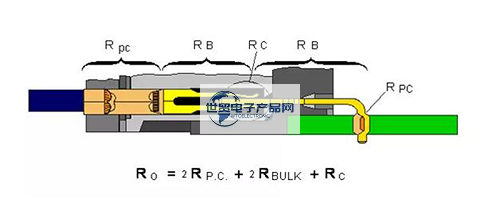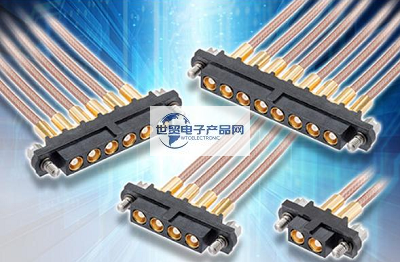Categorization:Product Information
Connector degradation mechanism is very important to connector performance, and it is crucial to the performance guarantee of related products. What is the degradation mechanism? What factors cause connector failure? We will continue to explore this issue. Connectors are used for connection between two separate systems. Separability is necessary for many reasons, from the ease of manufacturing to the improvement of performance. However, when matched, the connectors should not increase any unnecessary resistance values between systems. Increasing the resistance value may cause signal distortion or power loss and cause system failure. Connector degradation mechanisms are important because they are a potential source of increased resistance and, therefore, over time, lead to functional failure. Let's start by briefly reviewing the connector's resistance. FIG. 1 shows a cross-section of a universal signal connector. The equations in FIG. 1 represent various resistance sources within the connector. Ro is the overall resistance of the connector, which is the resistance between the end point of the conductor tail and the solder point of the PCB connector pin. The two permanent connection resistances Rp.c refer to the resistance between the finger connection contact and the corresponding pin. Similarly, the two body resistances (Rbulk) refer to the rear contact body resistance and the parallel resistance between the two posts of the connector; There is also a contact resistance Rc at the interface or separation. The overall connector resistance is the sum of the individual invariant connection resistances, the rear contact and cavity connection resistances, and the contact resistances at separable places, since all of these resistances are connected in series. For example, schematic diagram of connector resistance

------------------------------------------------------------------------------------------------------
For the sake of discussion, let us assume that the total resistance value Ro is measured to be 15 milliohms. Considering this assumption, we guess the relative effects of permanent connection resistance, bulk resistance and contact resistance at separable places on the overall connector resistance. In this example, these values are the resistance values of a typical soft-shell connector, and the bulk resistance will account for the majority of the total resistance, close to 14 milliohms. The permanent connection resistance is several hundred microohms, and the others are contact resistances at separable places. While the body resistance of the connector contacts is the largest contributor to the connector resistance, it is also the most stable. The bulk resistance of a single contact is determined by the material from which the contact is made and its overall geometry. Such as phosphor bronze and contact geometry, these parameters are constant, so the overall resistance of the connector is constant. The permanent connection resistance and the interface or detachable connection resistance are variable. These resistances are susceptible to a variety of degradation mechanisms, which will be discussed in later articles. It should be pointed out that connectors are affected by many effects, such as harsh environment, heat, life, vibration, etc. And the overall connector resistance may vary from the original 15 milliohms to, for example, 100 milliohms, with the variation in resistance mainly occurring in the separable and permanently connected resistance. The separable interface resistance is the most susceptible to degradation because of the generation of forces and deformations, etc. at the separability. Simply put, the two main separable interfaces require the generation of certain forces and deformations. The bite force of the connector is the first and most obvious requirement. For high PIN number connectors, the bite force of a single PIN bit must be controlled, and the contact normal force is one of the main parameters restricted by this requirement. For example, a detachable connection contact force is tens to hundreds of grams, while an insulated crimp connection, or IDC, has a force on the order of several kilograms, as is the force in the corresponding press-in connection. The high forces in this permanent connection provide greater mechanical stability and lower resistance values, much lower than the resistance values of separable connections. Likewise, higher permanent connection forces allow greater deformation of the contact surface relative to separable connections. Crimp connections are the most obvious examples, such as significant deformation of crimp terminals, and significant deformation of individual conductors. Both the force of the crimp connection and the corresponding PIN foot allow for a greater deformation of the contact surface. As with higher forces, the larger surface deformation of permanent connections reduces their resistance compared to the separable contact resistance. Deformation of separable connection surfaces is also limited by another separable interface requirement: fit durability. High surface deformation usually leads to high surface wear, which in turn may lead to loss of contact coating, such as gold or tin on the contact surface. The loss of this coating will increase the corrosion susceptibility of the contact surfaces, which will be discussed in a later article. The combination of bite force and bite durability of the separable interface limits the deformation and mechanical stability of the separable interface compared to the permanent connection, and is also responsible for the lower electrical stability of the separable interface. In general, the larger the contact area between the two surfaces, the lower the resistance of the interface. Since the contact area of the separable connections is lower than that of the permanent connections, they have a higher electrical resistance. In summary, the decreased force of the separable connection results in a decreased mechanical stability and the decreased contact area results in a higher electrical resistance compared to a permanent connection.

---------------------------------------------------------------------------------------------------------------------------------------------------------------------------------------------------------------------------------------------------------------------------------------------------------- If you have related [connector wiring harness and cable products] purchasing/purchasing needs or want to purchase/understand which connector wiring harness and cable product solutions we can provide, please contact our business staff below; If you have related [Connector Wiring Harness Cable Products] sales/resources and promotion needs, please click "→ Business Cooperation ←" to negotiate with a dedicated person!